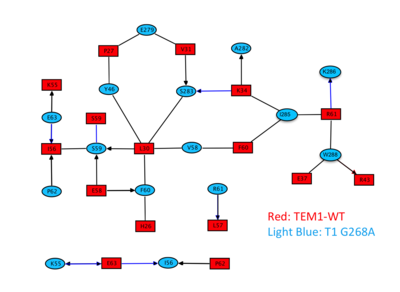Promiscuous Protein Binding as a Function of Protein Stability
Ruth Cohen-Khait, Orly Dym, Shelly Hamer-Rogotner and Gideon Schreiber [1]
Molecular Tour
Protein-protein interactions (PPI) mediate most major processes in the cell. Despite the crowded cellular environment, proteins maintain a high degree of specificity in their interactions. For this, proteins evolved to balance between the ability to bind the desired partners while rejecting all other proteins.
Here, we address the question of the sequence distance to generate new binding. In other words, how many mutations have to be inserted into a protein so that it will bind a given partner. For this we generated a random library of TEM1-β-lactamase mutant proteins displayed on yeast and selected the library to bind TEM1 wild-type. We found that three mutations were sufficient to develop a (see Table below). The position of each of the selected mutations is represented as orange sticks on the TEM1-WT scaffold (PDB 1jtg chain A).

The identities of the mutations present in the 4 selected clones are provided in the table
The mutations severely destabilized the protein, making them accessible only on a pre-stabilized TEM1 variant[2]. The X-ray structure of the complex formed between the mutant TEM1 (termed T1 G268A) and TEM1 wild-type showed the two proteins to be related by a . The interface is comprised of strand 2 from both proteins forming a , which spans to strand 1 and forms a . The most surprising feature of the complex is that helix 1 of T1 G268A is completely missing in the density map. shows that a properly folded N'-helix in T1 G268A would physically interfere with the interaction, making complex formation impossible. .
A closer look at the three mutations evolved during selection shows that two of them (E37K and E58V) are important in stabilizing the N'-helix in its position. Analysis of the (1btl) shows that , which in turn , which . . Therefore, loosing E37 and E58 will destabilize the N'- helix, as indeed seen in the . The two additional selected mutations, K32 and A36 in some of the clones probably also contribute to destabilization of the N'helix. The only selected mutation located directly in the binding interface is E58V, which is present in all four selected clones. . The structure implies that the formed interaction would be very specific between the evolved mutants and TEM1-WT. The structure of the complex shows that one copy of the between the two proteins. Hence the WT cannot dimerize since the N'-helix physically interferes with the interaction while the selected TEM1 proteins are missing a folded N'-helix. A detailed map of the interactions formed between the two proteins is presented in the figure below.

Interacting residues from both proteins as predicted by AquaPort
[3] are presented in red (TEM1-WT) and light blue (T1 G268A). The chemical bond formed between the interacting residues is indicated by the type of their connecting line, black: hydrophobic; blue: polar; line: interaction via side chain; arrow: interaction via main chain.



